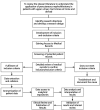Integration of minimally invasive techniques and interventional therapy: application of percutaneous nephrolithotomy in patients with upper urinary tract stones and an analysis of risk factors for postoperative bleeding
- PMID: 40385576
- PMCID: PMC12081443
- DOI: 10.3389/fmed.2025.1556224
Integration of minimally invasive techniques and interventional therapy: application of percutaneous nephrolithotomy in patients with upper urinary tract stones and an analysis of risk factors for postoperative bleeding
Abstract
Background: Percutaneous nephrolithotomy is one of the preferred treatment options for upper urinary tract stones. However, postoperative bleeding remains a clinical challenge. It is crucial to identify the effectiveness of this procedure and understand the risk factors causing postoperative bleeding.
Methods: A total of 383 patients with upper urinary tract stones included in our hospital from March 2020 to February 2024 were retrospectively selected and divided into 2 groups as per different treatments. A total of 204 patients who underwent guidewire-assisted percutaneous nephrolithotomy were included in the guidewire-assisted group, while the other 179 patients who underwent conventional percutaneous nephrolithotomy were enrolled in the conventional group for a comparison of treatment effects. Then, single-factor and multifactorial logistic regressions in accordance with the postoperative bleeding situation were conducted to analyze the risk factors of postoperative bleeding in patients with upper urinary tract stones.
Results: The results showed that the guidewire-assisted percutaneous nephrolithotomy group had a higher stone removal rate compared to the conventional group, with lower rates of complications, operation time, gastrointestinal recovery time, hospital stay, postoperative bleeding, and hemoglobin drop (p < 0.05). There was no significant difference in stone recurrence rate (p > 0.05). Among the 383 patients studied, 39 experienced severe bleeding (≥400 mL), while 344 had minor bleeding (<400 mL). Factors significantly associated with postoperative bleeding included the history of diabetes, preoperative blood creatinine, surgical method, staghorn calculi, hydronephrosis, and renal parenchymal thickness difference (p < 0.05). However, collinearity was noted between diabetes history and staghorn calculi. After adjustment of these variables, preoperative blood creatinine, surgical modality, hydronephrosis, and renal parenchymal thickness emerged as key predictors of postoperative bleeding.
Conclusion: Compared to conventional percutaneous nephrolithotomy, guidewire-assisted percutaneous nephrolithotomy could improve the stone removal rate of patients with upper urinary tract stones and reduce the occurrence of complications, while some patients were still prone to the postoperative bleeding phenomenon, which might be closely related to the preoperative Scr, surgical methods, hydronephrosis, and renal parenchymal thickness. The mentioned phenomenon needed clinical attention and corresponding measures to intervene as soon as possible to reduce the bleeding in the postoperative period.
Keywords: guidewire-assisted; percutaneous nephrolithotomy; postoperative bleeding; risk factors; upper urinary tract stone.
Copyright © 2025 Sun and Chen.
Conflict of interest statement
The authors declare that the research was conducted in the absence of any commercial or financial relationships that could be construed as a potential conflict of interest.
Figures
Similar articles
-
The Analysis of Risk Factors for Hemorrhage Associated with Minimally Invasive Percutaneous Nephrolithotomy.Biomed Res Int. 2019 Jan 30;2019:8619460. doi: 10.1155/2019/8619460. eCollection 2019. Biomed Res Int. 2019. PMID: 30834279 Free PMC article.
-
Comparison of mini endoscopic combined intrarenal surgery and multitract minimally invasive percutaneous nephrolithotomy specifically for kidney staghorn stones: a single-centre experience.BMC Urol. 2022 Jun 30;22(1):93. doi: 10.1186/s12894-022-01030-7. BMC Urol. 2022. PMID: 35773639 Free PMC article.
-
The High Risk Factors and Preventive Measures of Percutaneous Nephrolithotomy under the Guidance of B-Ultrasound in the Treatment of Postoperative Renal Calculi.Evid Based Complement Alternat Med. 2022 Jul 21;2022:1287910. doi: 10.1155/2022/1287910. eCollection 2022. Evid Based Complement Alternat Med. 2022. Retraction in: Evid Based Complement Alternat Med. 2023 Jun 21;2023:9810536. doi: 10.1155/2023/9810536. PMID: 35911133 Free PMC article. Retracted.
-
Comparison of the Efficacy and Complications of Soft Ureteroscopy Lithotripsy and Percutaneous Nephrolithotomy in the Treatment of Urinary Calculi: A Systematic Review and Meta-analysis.Comput Math Methods Med. 2022 Jul 1;2022:5829205. doi: 10.1155/2022/5829205. eCollection 2022. Comput Math Methods Med. 2022. Retraction in: Comput Math Methods Med. 2023 Jun 28;2023:9768470. doi: 10.1155/2023/9768470. PMID: 35813431 Free PMC article. Retracted.
-
Single- versus Multiple-Tract Percutaneous Nephrolithotomy in the Surgical Management of Staghorn Stones or Complex Caliceal Calculi: A Systematic Review and Meta-analysis.Biomed Res Int. 2020 Dec 17;2020:8817070. doi: 10.1155/2020/8817070. eCollection 2020. Biomed Res Int. 2020. PMID: 33381587 Free PMC article.
References
LinkOut - more resources
Full Text Sources



